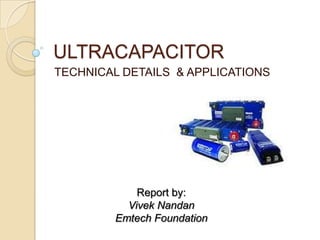
Ultracapacitors
- 1. ULTRACAPACITOR TECHNICAL DETAILS & APPLICATIONS Report by: VivekNandan Emtech Foundation
- 2. Table of contents 1.Introduction. 2.Attractive Features. 3.Advantages to conventional Energy Storing Devices. 4.Inside a Supercapacitor/Ultracapacitor. 5.Working. 6.Applications. 7.Drawbacks.
- 3. Introduction What is a Ultracapacitor? A charge storing device(Capacitor) . Differ in constructional features with respect to simple capacitors. Has ability to store tremendous charge. Capacitance ranges up to 5000F! Also called Super capacitor or Double-layered capacitor. Invented by Engineers at Standard Oil,1966.
- 4. Attractive Features Capacitance ranges to 5000 F. No chemical reaction involved. Much more effective at rapid, regenerative energy storage than chemical batteries . Works even at low temperatures -40 degrees Celsius. Ultracapacitors can store 5 percent as much energy as a modern lithium-ion battery. 5000 farads measure about 5 centimeters by 5 cm by 15 cm, which is an amazingly high capacitance relative to its volume. Can effectively fulfill the requirement of High current pulses that can kill a battery if used instead.
- 7. Degrade within a few thousand charge-discharge cycles. Ulracapacitors can have more than 300 000 charging cycles, which is far more than a battery can handle.
- 8. Ultra capacitor charges within seconds whereas batteries takes hrs.
- 9. Because no chemical reaction is involved, ultracapacitors--also known as supercapacitors and double-layer capacitors--are much more effective at rapid, regenerative energy storage than chemical batteries are.
- 11. Put two ordinary capacitors the size of a D-cell battery in your flashlight, each charged to 1.5 volts, and the bulb will go out in less than a second, if it lights at all. An ultracapacitor of the same size, however, has a capacitance of about 350 farads and could light the bulb for about 2 minutes.
- 14. Constructional Features Originally electrodes were made of aluminum. Standard Oil engineers coated these aluminum with 100-micrometer-thick layer of carbon. The carbon was first chemically etched to produce many holes that extended through the material, as in a sponge, so that the interior surface area was about 100 000 times as large as the outside. (This process is said to ”activate” the carbon.) They filled the interior with an electrolyte and used a porous insulator, one similar to paper, to keep the electrodes from shorting out. carbon is inert and does not react chemically with the ions attached to it. Nor do the ions become oxidized or reduced, as they do at the higher voltages used in an electrolytic cell.
- 15. Working When a voltage is applied, the ions are attracted to the electrode with the opposite charge, where they cling electrostatically to the pores in the carbon. At the low voltages used in ultracapacitors, carbon is inert and does not react chemically with the ions attached to it. Nor do the ions become oxidized or reduced, as they do at the higher voltages used in an electrolytic cell. As the effective area where ions are stuck is much larger, appreciably high value of capacitance is obtained.
- 16. Modern Ultracapacitors Nanotechnology is being employed in the design. The active carbon is replaced by a thin layer of billions of Nanotubes . Each Nanotube is like a uniform hollow cylinder with 5nm and 100 µm long. These Nanotubes are verically grown over the conducting electrodes.
- 19. The material must be ”glued” to the aluminum current collector using a binder, which exhibits a somewhat high resistance.
- 20. Carbon Nanotubes
- 21. Depending on their geometry, can be excellent conductors .Thus they can supply more power than ultracapacitors outfitted with activated carbon.
- 23. Drawbacks of Ultracapacitors Linear discharge voltage prevents use of the full energy spectrum Low energy density - typically holds one-fifth to one-tenth the energy of an electrochemical battery Cells have low voltages - serial connections are needed to obtain higher voltages. Voltage balancing is required if more than three capacitors are connected in series High self-discharge - the rate is considerably higher than that of an electrochemical battery. Requires sophisticated electronic control and switching equipment
- 24. Questions?
Notas do Editor
- Introduction,attractivefeatures,advantages to conventional energy storing devices,inside a supercapacitor,working ,applications,summary
